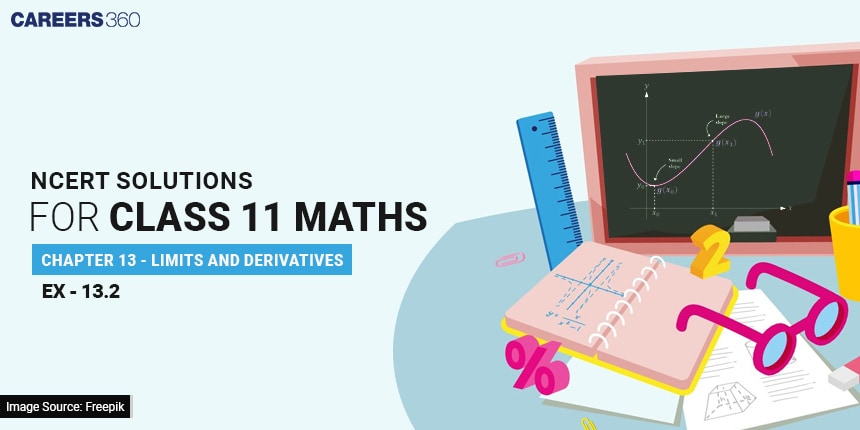Aakash Repeater Courses
ApplyTake Aakash iACST and get instant scholarship on coaching programs.
The concept of derivatives is explained in this exercise. In our daily life, we often observe situations where one quantity changes with respect to another, like the speed of a moving car, rise in water level in the oceans or reservoirs, or a change in prices of stocks with time. In mathematics, these concepts are explained using the concept of derivatives. Derivative is defined as the rate at which one quantity changes with respect to another or how fast or slow something is changing at a particular moment. The concept of derivatives forms the foundation for higher-level calculus.
JEE Main Scholarship Test Kit (Class 11): Narayana | Physics Wallah | Aakash | Unacademy
Suggested: JEE Main: high scoring chapters | Past 10 year's papers

In NCERT, students will learn how to determine the derivatives of algebraic, polynomial, and trigonometric functions. NCERT Solutions of Exercise 12.2 are designed by subject experts in a very comprehensive and systematic manner that ensures the accuracy of the solutions. Derivatives help us to calculate how things change, which is useful in science, engineering, and economics. Check NCERT Solutions to get detailed solutions for Science and Maths from Class 6 to Class 12.
Question1: Find the derivative of
Answer:
F(x)=
Now, As we know, The derivative of any function at x is
The derivative of f(x) at x = 10:
Question 2: Find the derivative of x at x = 1.
Answer:
Given
f(x)= x
Now, As we know, The derivative of any function at x is
The derivative of f(x) at x = 1:
Question 3: Find the derivative of 99x at x = l00.
Answer:
f(x)= 99x
Now, As we know, The derivative of any function at x is
The derivative of f(x) at x = 100:
Question 4: (i) Find the derivative of the following functions from first principle.
Answer:
Given
f(x)=
Now, As we know, The derivative of any function at x is
Question 4:(ii) Find the derivative of the following function from first principle.
Answer:
f(x)=
Now, As we know, The derivative of any function at x is
Question 4:(iii) Find the derivative of the following functions from first principle.
Answer:
f(x)=
Now, As we know, The derivative of any function at x is
Question 4:(iv) Find the derivative of the following functions from first principle.
Answer:
Given:
Now, As we know, The derivative of any function at x is
Question 5: For the function
Answer:
As we know, the property,
applying that property we get
Now.
So,
Here
Hence Proved.
Question 6: Find the derivative of
Answer:
Given
As we know, the property,
applying that property we get
Question 7:(i) For some constants a and b, find the derivative of
Answer:
Given
As we know, the property,
and the property
applying that property we get
Question 7:(ii) For some constants a and b, find the derivative of
Answer:
Given
As we know, the property,
and the property
applying those properties we get
Question 7:(iii) For some constants a and b, find the derivative of
Answer:
Given,
Now As we know the quotient rule of derivative,
So applying this rule, we get
Hence
Question 8: Find the derivative of
Answer:
Given,
Now As we know the quotient rule of derivative,
So applying this rule, we get
Hence
Question 9:(i) Find the derivative of
Answer:
Given:
As we know, the property,
and the property
applying that property we get
Question 9:(ii) Find the derivative of
Answer:
Given.
As we know, the property,
and the property
applying that property we get
Question 9:(iii) Find the derivative of
Answer:
Given
As we know, the property,
and the property
applying that property we get
Question 9:(iv) Find the derivative of
Answer:
Given
As we know, the property,
and the property
applying that property we get
Question 9:(v) Find the derivative of
Answer:
Given
As we know, the property,
and the property
applying that property we get
Question 9:(vi) Find the derivative of
Answer:
Given
As we know the quotient rule of derivative:
and the property
So applying this rule, we get
Hence
Question 10: Find the derivative of
Answer:
Given,
f(x)=
Now, As we know, The derivative of any function at x is
Question 11:(i) Find the derivative of the following functions:
Answer:
Given,
f(x)=
Now, As we know the product rule of derivative,
So, applying the rule here,
Question 11:(ii) Find the derivative of the following functions:
Answer:
Given
Now As we know the quotient rule of derivative,
So applying this rule, we get
Question 11: (iii) Find the derivative of the following functions:
Answer:
Given
As we know the property
Applying the property, we get
Question 11:(iv) Find the derivative of the following functions:
Answer:
Given :
Now As we know the quotient rule of derivative,
So applying this rule, we get
Question 11:(v) Find the derivative of the following functions:
Answer:
Given,
As we know the property
Applying the property,
Now As we know the quotient rule of derivative,
So applying this rule, we get
Question 11:(vi) Find the derivative of the following functions:
Answer:
Given,
Now as we know the property
So, applying the property,
Question 11:(vii) Find the derivative of the following functions:
Answer:
Given
As we know the property
Applying this property,
Also read
Exercise 12.2 introduces students to the derivative of a function. In this, students will find questions that primarily revolve around the following key topics:
1) Derivatives: Derivative is the measure of the rate at which the function is changing at a given point.
Mathematically derivative of the function f(x) at point x=a is
The instantaneous rate of change of a function at point a’ is shown by this formula.
2) Algebra of derivative of function : Rules used to find the differentiation of the combination of functions.
3) Derivative of Polynomial :
4) Derivatives of Trigonometric functions :
Also Read
Students can refer to the subject-wise NCERT solutions. The links to solutions are given below:
Students can access the NCERT exemplar solutions to enhance their deep understanding of the topic. These solutions are aligned with the CBSE syllabus and also help in competitive exams.
The value of f(x) at 100 =8000
The derivative of 80x is 80 which is a constant
The derivative of
The derivative of ‘a’ =0 since ‘a’ is a constant
Since the rate of change of constant =0, the derivative =0
11 questions are solved from exercise 12.2 Class 11 Maths
Definition of derivative, derivative of polynomial and trigonometric functions.
Exam Date:22 July,2025 - 29 July,2025
Exam Date:22 July,2025 - 28 July,2025

Take Aakash iACST and get instant scholarship on coaching programs.

This ebook serves as a valuable study guide for NEET 2025 exam.

This e-book offers NEET PYQ and serves as an indispensable NEET study material.

As per latest syllabus. Physics formulas, equations, & laws of class 11 & 12th chapters
As per latest syllabus. Chemistry formulas, equations, & laws of class 11 & 12th chapters
As per latest 2024 syllabus. Study 40% syllabus and score upto 100% marks in JEE